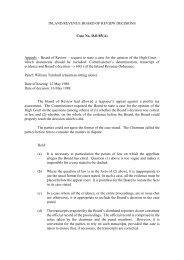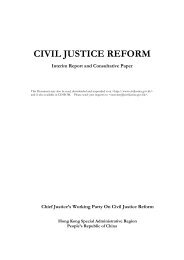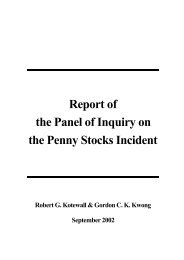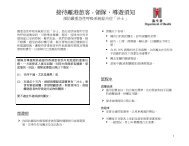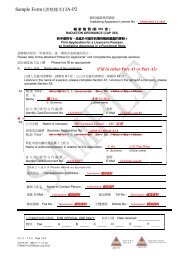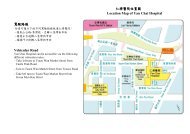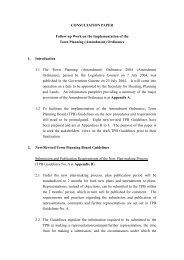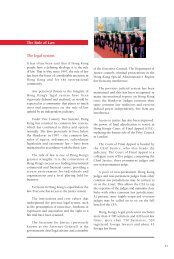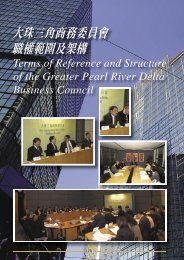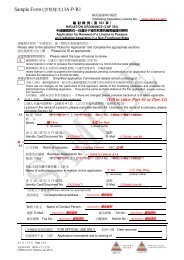430 Case No. D41187 Board of Review: Andrew K. N. Li, Chairman ...
430 Case No. D41187 Board of Review: Andrew K. N. Li, Chairman ...
430 Case No. D41187 Board of Review: Andrew K. N. Li, Chairman ...
You also want an ePaper? Increase the reach of your titles
YUMPU automatically turns print PDFs into web optimized ePapers that Google loves.
<strong>430</strong> INLAND REVENUE BOARD OF REVIEW DECISIONS<br />
<strong>Board</strong> <strong>of</strong> <strong>Review</strong>:<br />
<strong>Case</strong> <strong>No</strong>. <strong>D41187</strong><br />
<strong>Andrew</strong> K. N. <strong>Li</strong>, <strong>Chairman</strong>, J. S. Brooker and Richard Mills-<br />
Owens, Members.<br />
14 December 1987.<br />
Pr<strong>of</strong>its Tax-whether the gain realised on the acquisition and disposal <strong>of</strong> an asset an<br />
adventure in the nature <strong>of</strong> trade or a capital gain.<br />
The Appellant company is the wholly owned subsidiary <strong>of</strong> an Investment Company<br />
whose Directors and shareholders were members <strong>of</strong> a family. The Appellant companv<br />
acquired 30% <strong>of</strong> the issued capital <strong>of</strong> the company M whdse only asset was the ;ighi<br />
to acquire portion <strong>of</strong> a property which was under construction in 1979. The balance<br />
<strong>of</strong> 70% was acquired by an individual. In late 1979 the property developer nominated<br />
company M to take up the option to purchase the property and company M began<br />
paying the instalments. The Appellant company's acquisition <strong>of</strong> its 30% interest was<br />
dependent on financing from its parent company which at that time had few projects<br />
in hand involving substantial investments.<br />
In late 1980 the Appellant company and the individual shareholder sold their entire<br />
shareholding to another company and in that process made a pr<strong>of</strong>it <strong>of</strong> HK$5.9<br />
million. The original intention was nevertheless a long term investment but the<br />
disposal took place because the property market was s<strong>of</strong>tening in 1980.<br />
Held:<br />
The 30% shareholding held was a capital investment and not an adventure in the<br />
nature <strong>of</strong> trade.<br />
Appeal allowed<br />
<strong>Case</strong>s referred to:<br />
CIR v. Reinhold 119531 34 TC 389<br />
Marson v. Morton [l9861 1 WLR 1343<br />
Simmons v. IRC [l9801 2 All ER 798<br />
West v. Phillips [l 9581 38 TC 203<br />
Wong Chi-wah for the Commissioner <strong>of</strong> Inland Revenue.<br />
Anthony G. Rogers, Q.C. for the Appellant.<br />
Reasons:<br />
Introduction<br />
This is an appeal by LHE against its pr<strong>of</strong>its tax assessment for<br />
198018 1.<br />
In December 1979 LHE acquired 30% <strong>of</strong> the issued capital <strong>of</strong> M<br />
<strong>Li</strong>mited. The balance <strong>of</strong> 70% was acquired by one Mr. L. In October<br />
1980, LHE and Mr. L sold the entire issued capital <strong>of</strong> M <strong>Li</strong>mited.<br />
The only asset <strong>of</strong> M <strong>Li</strong>mited was the right to acquire the <strong>of</strong>fice<br />
space on one floor <strong>of</strong> U Centre which was then in the course
INLAND REVENUE BOARD OF REVIEW DECISIONS<br />
43 1<br />
<strong>of</strong> construction. The gain made by LHE on the acquisition and<br />
disposal <strong>of</strong> its 30% amounted to $5,953,708. The issue on this appeal<br />
is whether this amount was the pr<strong>of</strong>it <strong>of</strong> an adventure in the nature<br />
<strong>of</strong> trade or was a capital gain on the realisation <strong>of</strong> a capital asset.<br />
LHE did not <strong>of</strong>fer this sum for assessment. But the assessor<br />
treated this sum as pr<strong>of</strong>its chargeable to pr<strong>of</strong>its tax. Taking into<br />
account the loss <strong>of</strong> $1,980 as per LHE's accounts, he assessed the<br />
pr<strong>of</strong>its at $5,951,728 ($5,953,708-$1,980) with tax payable thereon<br />
<strong>of</strong> $982,035. The Commissioner confirmed the assessment.<br />
At the hearing before us, Mr. A. Rogers, Q.C. appeared for LHE.<br />
Messrs. PR and OR, directors <strong>of</strong> LHE gave evidence. Mr. Wong<br />
Chi-wah appeared for the Revenue.<br />
The Facts<br />
For reasons explained below, we do not express any view as to<br />
whether the evidence <strong>of</strong> PR and OR in relation to RC Garden<br />
should be accepted. Subject to this, we found PR and OR to be<br />
truthful witnesses. On the basis <strong>of</strong> the documentary and oral<br />
evidence before us we find the following facts.<br />
The corporate background<br />
LHE was a wholly owned subsidiary <strong>of</strong> AF <strong>Li</strong>mited. The late<br />
Mr. R founded this company many years ago. Its directors and<br />
shareholders were members <strong>of</strong> his family. During his lifetime he ran<br />
the company. He was a conservative businessman <strong>of</strong> the old school.<br />
His policy was that borrowing should be avoided and pr<strong>of</strong>its should<br />
be reinvested. So, during his lifetime AF <strong>Li</strong>mited did not pay any<br />
dividends. He died in 1978. After his death, his son PR became<br />
managing director and ran the company. On matters <strong>of</strong> policy, he<br />
consulted OR, the grandson <strong>of</strong> Mr. R and the nephew <strong>of</strong> PR who<br />
has been a director since 1968. They made the policy decisions.<br />
Messrs. PR and OR were influenced by the conservative policy laid<br />
down by Mr. R. They avoided borrowing and did not pay any<br />
regular dividends though it paid dividends on two occasions after<br />
the death <strong>of</strong> Mr. R because family members needed money. AF<br />
<strong>Li</strong>mited had a number <strong>of</strong> subsidiaries. Both before and after the<br />
death <strong>of</strong> its founder, it was basically an investment company holding<br />
properties and some shares.<br />
The purchase<br />
In late 1979, U Centre was in the initial stage <strong>of</strong> construction.<br />
Because <strong>of</strong> restrictions in the Conditions <strong>of</strong> Grant, no agreements
432 INLAND REVENUE BOARD OF REVIEW DECISIONS<br />
for sale and purchase could be concluded. But the developer entered<br />
into agreements granting options to purchase. The authorities did<br />
not challenge this and these agreements were treated in the market<br />
place as the purchase <strong>of</strong> the premises.<br />
PR was <strong>of</strong>fered one floor. The vendor had entered into such an<br />
agreement with the developer at the price <strong>of</strong> $27,660,000 <strong>of</strong> which<br />
the first instalment <strong>of</strong> $1,383,000 had been paid. The balance had<br />
to be paid by four further instalments <strong>of</strong> $1,383,000 each on the<br />
completion <strong>of</strong> RCC works up to various stages with the final tranche<br />
<strong>of</strong> $20,745,000 payable on completion <strong>of</strong> the building. The vendor<br />
required payment <strong>of</strong> $6,812,735 (the first instalment <strong>of</strong> $1,383,000<br />
plus a "premium7' <strong>of</strong> $5,429,735). So the purchaser had to pay that<br />
sum and be responsible for the further payments to the developer.<br />
The total consideration for the 14th Floor would come to<br />
$33,089,735. ($6,812,735 to the vendor + $5,532,000 being 4 further<br />
instalments <strong>of</strong> $1,383,000 + $20,745,000 on completion) With an<br />
area <strong>of</strong> 20,489 sq. ft. the cost came to about $1,615 per sq. ft.<br />
PR's idea was for the AF Ltd. group to take a 50% interest<br />
and he would get Mr. L to take the other 50%. Mr. L is a well<br />
known businessman. PR knew him well for many years.<br />
PR consulted OR on the proposed purchase. After assessing the<br />
cash flow <strong>of</strong> the Group and the requirements <strong>of</strong> the development <strong>of</strong> a<br />
composite building at H Road which AF Ltd. was undertaking, OR<br />
was <strong>of</strong> the view that a 50% participation was too much. He thought<br />
that they could manage a 30% participation comfortably. Even if<br />
there were insufficient cash, they would only have to borrow about<br />
$2 million for about 1 year or sell some shares. PR reluctantly<br />
agreed.<br />
PR approached Mr. L who would take 70%. He told Mr. L that<br />
the property would be a long term investment and Mr. L agreed.<br />
Mr. L was keen to purchase as he regarded the <strong>of</strong>fer price <strong>of</strong> $1,615<br />
per sq. ft. as below the market price.<br />
On 23 <strong>No</strong>vember 1979 the vendor nominated M Ltd. to take<br />
up the option to purchase the property. On 18 December 1979,<br />
M Ltd. allotted shares as to 30% to LHE and as to 70% to Mr. L.<br />
By a board minute <strong>of</strong> 16 December 1979 LHE resolved to invest<br />
for long term investment in 3O0/0 in M Ltd. The minute noted that<br />
the directors <strong>of</strong> M Ltd. intended to acquire the property for long<br />
term investment. It was further resolved to obtain from the holding<br />
company as and when required the amounts necessary to pay the<br />
instalments. The minute was drawn up to record the conclusion
?-<br />
INLAND REVENUE BOARD OF REVIEW DECISIONS 433<br />
reached by PR and OR. The reference to the intention <strong>of</strong> the direc-<br />
tors <strong>of</strong> M Ltd. was based on PR's conversation with Mr. L. Mr. L<br />
and his daughter were directors <strong>of</strong> M Ltd. PR and OR were not<br />
represented on that board.<br />
PR and OR decided to take a 30% stake because they thought it<br />
would be a good investment. They estimated the rental on completion<br />
to be about $20 per sq. ft. In using this figure OR who is an<br />
executive director <strong>of</strong> W Ltd. had asked people in his <strong>of</strong>fice although<br />
no pr<strong>of</strong>essional opinion was sought from a surveyor. This would<br />
make the gross yield on the purchase price to be 14.86% which was<br />
very good. The property is in Central and the AF Ltd. Group had no<br />
property in Central. Although it was not in the traditional heart <strong>of</strong><br />
Central, it had good accessibility by MTR.<br />
Further, PR had at the back <strong>of</strong> his mind the possibility <strong>of</strong> moving<br />
his <strong>of</strong>fices as a solicitor into the property or part <strong>of</strong> it paying rent to<br />
M Ltd. although he did not mention this to anyone at the time.<br />
OR produced a draft shareholders agreement for PR to discuss<br />
with Mr. L. PR said this was unnccessary in view <strong>of</strong> the long<br />
standing and good relationship between them.<br />
Financial ability<br />
LHE decided to acquire its 30% interest in <strong>No</strong>vember/December<br />
1979. It was dependent on financing from its parent company AF<br />
Ltd. Looking at the position in late 1979, could the Group afford the<br />
30% acquisition?<br />
For its 30% commitment, LHE had to pay the following sums:<br />
$2,043,825.50 on acquisition, $1,659,600 by 4 instalments <strong>of</strong><br />
$414,900 each (these were in fact paid between April and September<br />
1980) and $6,223,550 on completion <strong>of</strong> the building.<br />
OR gave evidence that looking at the position in late 1979 AF<br />
Ltd. could finance this 30% commitment. At most it would have to<br />
borrow about $2 million for about 1 year or realize some shares. We<br />
accept this evidence which was supported by the financial materials<br />
before us. Indeed the Revenue did not dispute this. It accepted that<br />
there were sufficient financial resources for the 30% acquisition with<br />
marginal short term borrowing or the selling <strong>of</strong> shares.<br />
We had the following financial materials before us to support the<br />
evidence <strong>of</strong> OR. The group balance sheet <strong>of</strong> AF Ltd. shows that as<br />
at 31 March 1980, the group had quoted investments with a market<br />
value <strong>of</strong> $5,107,870 and bank and cash balances <strong>of</strong> $5,898,955. So it
434 INLAND REVENUE BOARD OF REVIEW DECISIONS<br />
had some $1 1 million worth <strong>of</strong> liquid assets. It only had liabilities <strong>of</strong><br />
$660,222 <strong>of</strong> which $504,983 represented rental deposits. The audited<br />
balance sheet <strong>of</strong> course shows the position as at 31 March 1980. But<br />
we can infer that the position in late 1979 was similar.<br />
Further the following figures were produced in evidence to show the<br />
rental income, the expenditure and the recurrent surplus <strong>of</strong> AF Ltd.<br />
for various years. These were extracted from the audited accounts.<br />
Year ending Rental Inrorne E.xpenditure Surplus<br />
These figures were <strong>of</strong> course not available to PR and OR looking<br />
at the position at the end <strong>of</strong> 1979. But as at that time, they could<br />
estimate the rough order <strong>of</strong> the recurrent surplus in the coming<br />
years. They could foresee that the rental income and the surplus for<br />
the year ending 3 1 March 1982 would increase significantly as the H<br />
Road development would then be completed.<br />
As against such liquid assets and estimated surpluses, the only<br />
substantial capital commitment for the AF Ltd. group was the H<br />
Road development. (The above figures for recurrent expenditure <strong>of</strong><br />
course do not include capital expenditure) But by 31 March 1980,<br />
the sum <strong>of</strong> $4,322,195.92 had been incurred. A further sum <strong>of</strong><br />
$1,257,792.12 was incurred during the year ending 31 March 1981. It<br />
was completed during the year ended 31 March 1982 with the<br />
expenditure <strong>of</strong> a further sum <strong>of</strong> the order <strong>of</strong> $1,000,000. By the end<br />
<strong>of</strong> 1979, it would appear that a substantial part <strong>of</strong> such expenditure<br />
had been incurred.<br />
The AF Ltd. group also had a site at Bonham Strand and WL<br />
Street. The old building was demolished in 1977-1978. The con-<br />
struction cost was originally estimated to be about $2 million. By 31<br />
March 1980 a sum <strong>of</strong> $985,911.35 was incurred for site investigation.<br />
<strong>No</strong> expenditure was incurred during the year ended 3 1 March 198 1.<br />
The site was plagued by soil problems and development did not<br />
proceed. It would appear that by the end <strong>of</strong> 1979 the problems had<br />
been revealed (it was during the year 1 April 1979 to 31 March 1980<br />
that the above sum was spent on site investigation) and develop-<br />
ment was grinding to a halt.<br />
Trading Activities US the M Ltd. Group<br />
Before the end <strong>of</strong> 1979, when the 30% was acquired the AF Ltd.<br />
group had not previously traded in property or shares.
INLAND REVENUE BOARD OF REVIEW DECISIONS 43 5<br />
In July 1980, LHE and E Ltd. (also a subsidiary <strong>of</strong> AF Ltd.)<br />
successfully tendered for Sha Tin Town Lot by the use <strong>of</strong> Letters B<br />
they held. They developed a residential block with 16 units using first<br />
class materials known as RC Garden. It was completed in 1983. The<br />
cost was some $7 million apart from a premium <strong>of</strong> $1.7 million to<br />
Government. It was difficult to let and the units were then sold.<br />
2 units are still left. LHE and E Ltd. regarded it as a long term<br />
investment. The Revenue appears to dispute this. It is unnecessary<br />
for us to make any finding and there may be a dispute about this<br />
which we should not prejudice. We wish to make clear that we do<br />
not make any finding as to whether RC Garden was a capital<br />
investment or an adventure in the nature <strong>of</strong> trade or any finding as<br />
to whether the evidence <strong>of</strong> PR and OR on this matter should be<br />
accepted.<br />
After 1979, the AF Ltd. group embarked on a number <strong>of</strong><br />
transactions which were admittedly trading transactions. From the<br />
year ended 31 March 1981 it held a portfolio <strong>of</strong> quoted shares for<br />
trading. During that year, its subsidiary D <strong>Li</strong>mited acquired 4% in a<br />
property trading company, a joint venture with the H Group. That<br />
company owned land at Sai Kung which was resumed by Govern-<br />
ment. During the year ended 31 March 1982 its subsidiary, LD Ltd.<br />
took a one-ninth stake in HF <strong>Li</strong>mited which was a property trading<br />
company developing a site at Kowloon Bay. During the ycar ended<br />
31 March 1984, its subsidiary L1 Ltd. engaged in share dealing and<br />
commission agents (from underwriting for W Ltd.).<br />
The sale<br />
On 18 October 1980, LHE and Mr. L sold their shareholding<br />
being 100% <strong>of</strong> its issued capital to S <strong>Li</strong>mited. The sale was<br />
completed on 15 <strong>No</strong>vember 1980. The total consideration was<br />
$20,120,744.80. Further on completion, S <strong>Li</strong>mited would lend<br />
$12,045,655.20 to M Ltd. to enable it to repay the outstanding debt<br />
<strong>of</strong> that amount it owed to LHE and Mr. L.<br />
The sale was concluded in the following circumstances. Mr. L<br />
telephoned PR several times. He said that he wanted to dispose <strong>of</strong><br />
the property as the market was s<strong>of</strong>tening. PR said as far as he was<br />
concerned he was not selling. When PR tried to put him <strong>of</strong>f, Mr. L<br />
called OR to persuade him to agree to a sale. Mr. L invited them to<br />
lunch at the American Club. At this lunch, Mr. L insisted on selling<br />
despite the wish <strong>of</strong> PR and OR to hold as a long term investment.<br />
In view <strong>of</strong> the insistent attitude <strong>of</strong> Mr. L, Messrs. PR and OR had<br />
no alternative but go along with it. They were in a minority <strong>of</strong> 30%.
436 INLAND REVENUE BOARD OF REVIEW DECISIONS<br />
They did not want to be locked in with Mr. L selling his 70% to a<br />
stranger. They could not buy Mr. L out; they had earlier concluded<br />
that they should not take more than 30%. <strong>No</strong>r did they consider a<br />
partition. That was not regarded as possible presumably because <strong>of</strong><br />
the Conditions <strong>of</strong> Grant.<br />
After the lunch OR casually mentioned the property to the<br />
managing director <strong>of</strong> S <strong>Li</strong>mited as he knew they were looking for<br />
<strong>of</strong>fice premises to purchase. He is an executive <strong>of</strong> the H Bank<br />
seconded to W Ltd. which was responsible for the management in<br />
Hong Kong <strong>of</strong> S <strong>Li</strong>mited a subsidiary <strong>of</strong> a Philippine company. He<br />
expressed interest. OR gave him Mr. L's name and telephone<br />
number. He then negotiated direct with Mr. L and came to terms.<br />
PR and OR were not involved in the negotiation. They were<br />
presented with the concluded deal.<br />
Capital asset or adventure in the nature <strong>of</strong> trade?<br />
Uncompleted units in buildings in Hong Kong are <strong>of</strong>ten<br />
purchased for trading. Equally they are <strong>of</strong>ten purchased for invest-<br />
ment. Each case depends on its own facts and circumstances and the<br />
interaction between the various factors present. See Marson v.<br />
Morton (1986) 1 WLR 1343 at 1348 and CIR v. Reinhold (1953) 34<br />
TC at 39. A single one-<strong>of</strong>f transaction can be an adventure in the<br />
nature <strong>of</strong> trade. See Marson v. Morton at 1347H. The question is<br />
whether it was acquired with the intention <strong>of</strong> disposing <strong>of</strong> it at a<br />
pr<strong>of</strong>it or was it acquired as a permanent investment? Although<br />
intentions may change (what was first an investment may be put into<br />
trading stock and vice versa), we are not concerned with that in the<br />
present case; neither LHE nor the Revenue is contending that there<br />
was any change after acquisition. It is not possible for an asset to be<br />
both trading stock and permanent investment at the same time. <strong>No</strong>r<br />
can it possess an indeterminate status neither trading stock nor<br />
permanent asset. See Simmons v. IRC (1980) 2 AE 798 at 800 e-h.<br />
Frustration <strong>of</strong> a plan for investment, which compels realisation,<br />
even if foreseen as a possibility cannot give rise to an intention to<br />
trade. See Simmons at 802j.<br />
We note that the group had not engaged in habitual trading. As at<br />
the end <strong>of</strong> 1979, it had not previously traded in property or shares.<br />
That LHE acquired the 30% as a long term investment was stated in<br />
its contemporaneous board minute <strong>of</strong> 16 December 1979. That<br />
statement was a self-serving one and by itself is <strong>of</strong> little weight.<br />
But <strong>of</strong> great weight is the evidence <strong>of</strong> Messrs. PR and OR before<br />
us which has been tested by cross-examination. We have accepted
INLAND REVENUE BOARD OF REVIEW DECISIONS 437<br />
their evidence that as policy makers <strong>of</strong> the AF Ltd. group including<br />
LHE, their intention at the time <strong>of</strong> the acquisition <strong>of</strong> the 30% was to<br />
hold it as a long term investment. So LHE's intention at the time <strong>of</strong><br />
acquisition was to hold for long-term investment.<br />
That this was the intention at the time <strong>of</strong> acquisition is supported<br />
by a number <strong>of</strong> matters.<br />
First, as at the end <strong>of</strong> 1979 the acquisition appeared to be a good<br />
investment yielding a good return. Even accepting that the estimate<br />
<strong>of</strong> about $20 per sq. ft. with a gross return <strong>of</strong> 14.86% was on the<br />
optimistic side, the likcly return was still a good one.<br />
Secondly, the evidence before us establish that looking at the<br />
position in late 1979, the AF Ltd. group could finance the 30%<br />
acquisition without much difficulty. The group had substantial<br />
liquid resources, both cash and quotcd investments. The amount <strong>of</strong><br />
its liabilities was low. Significant recurrent surpluses were estimated<br />
for the coming years. As at the end <strong>of</strong> 1979 the capital expenditure<br />
on the H Road project was nearly completed and apart from this<br />
project the group did not have any heavy commitments. At that time<br />
the Sha Tin site had not been acquired. It was only acquired in July<br />
1980. At worst, the AF Ltd. would have to borrow some $2 million<br />
for a year or realize some quoted investments to pay its share<br />
amounting to $6,223,550 on completion <strong>of</strong> U Centre.<br />
Thirdly, at the time <strong>of</strong> acquisition, there appeared to be no<br />
problem in holding it as a long term investment although LHE was a<br />
30% minority in M Ltd. When PR approached Mr. L, he explained<br />
that the property would be held as a long term investment and Mr. L<br />
agreed. So they were ad idem. PR reasonably relied on that having<br />
regard to their good and long standing relationship. Mr. L changed<br />
his mind subsequently. But PR and OR could not have foreseen<br />
that.<br />
The time between acquisition and disposal was short, only 10<br />
months. That by itself would tend to be a pointer to trading. But it<br />
P- cannot be considered in isolation. The reason for the change from<br />
holding to realization "colours and colours heavily the whole<br />
matter". See West v. Phillips (l 958) 38 TC 203 at 21 3.<br />
Here the reason for the sale was that Mr. L changed his mind and<br />
Messrs, PR and OR in a 30% minority position had no practical<br />
alternative but to go along. As we have said, they could not have<br />
foreseen this. So in view <strong>of</strong> the particular circumstances here, the<br />
short time is explicable and does not support a trading intention.
438 INLAND REVENUE BOARD OF REVIEW DECISIONS<br />
Having regard to the above, we hold that the 30% in M <strong>Li</strong>mited<br />
held by LHE was a capital investment and not an adventure in the<br />
nature <strong>of</strong> trade. The gain on sale is therefore not chargeable to<br />
pr<strong>of</strong>its tax.<br />
Accordingly, we allow the appeal and annul the assessment in<br />
question.<br />
<strong>Board</strong> <strong>of</strong> <strong>Review</strong>.<br />
<strong>Case</strong> <strong>No</strong>. D44187<br />
Henry <strong>Li</strong>tton, <strong>Chairman</strong>, Della P. H. Chan and Charles Yeung<br />
Siu-cho. Members.<br />
22 October 1987.<br />
Pr<strong>of</strong>its Tax-whether "loss on exchange" and "loss on disposal <strong>of</strong> landed properties"<br />
allowable deductions.<br />
The Appellant company's business for the period 1980 to 1983 was property<br />
dealing and money lending. The source <strong>of</strong> funds for the money lending business was<br />
derived partly from an associated company based in Singaporc and partly from banks<br />
in Hong Kong. The pr<strong>of</strong>it margin derived by the Appellant company was in<br />
differential in interest rates charged, the Appellant company lending at higher rates <strong>of</strong><br />
interest than the rates at which it borrowed. The Appellant company and the<br />
borrowers had strong connections. The major shareholder in all those companies was<br />
the same person. The Appellant company lent to no one except the affiliated<br />
companies. The Appellant company was used as a conduit pipe to fund the business<br />
<strong>of</strong> the affiliated companies. The Appellant contended that the exchange loss from<br />
Singapore dollars to Hong Kong dollars as at 31 March 1983 together with the<br />
outstanding interest were deductible from the assessable pr<strong>of</strong>its.<br />
In August 1980 the Appellant company purchased a number <strong>of</strong> shop units. They<br />
were let to tenants and rental income was derived. For the year ending 31 March 1981<br />
it was reflected in the accounts as fixed assets and in two subsequent years this<br />
position was maintained. In the year ending 31 March 1983 the Appellant company<br />
disposed <strong>of</strong> a number <strong>of</strong> units and in that process incurred a loss. The Appellant<br />
company contended that the loss was deductible against the chargeable pr<strong>of</strong>its.<br />
Held:<br />
The loss incurred on the difference in exchange rates between the Hong Kong<br />
dollar and Singapore dollar as at 31 March 1983 was not a loss incurred in the<br />
carrying on <strong>of</strong> the Appellant company's business, but merely a charge in the<br />
accounts reflecting the difference between the rate <strong>of</strong> exchange at the time when the<br />
funds were borrowed and the 31 March 1983 when the line was drawn on the<br />
Appellant company's accounts. The loss on sale <strong>of</strong> the landed properties was a<br />
capital loss and was not therefore deductible against the chargeable pr<strong>of</strong>its.



